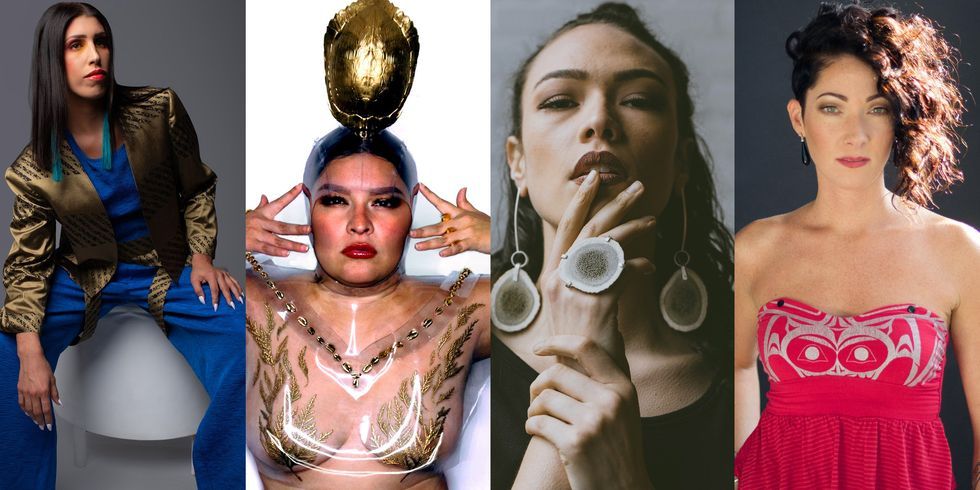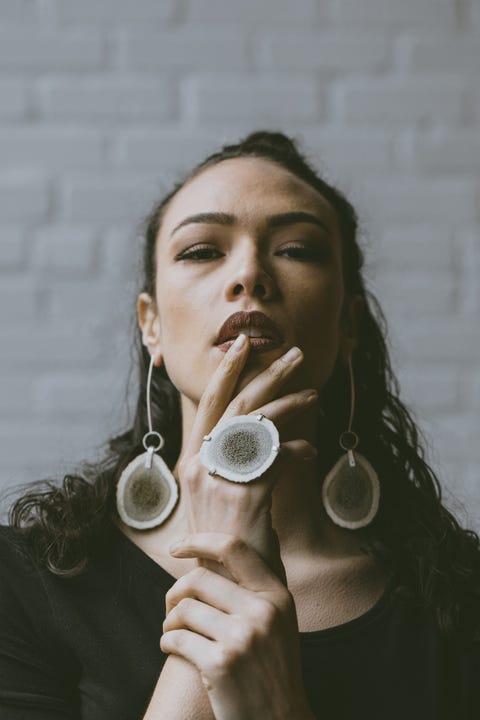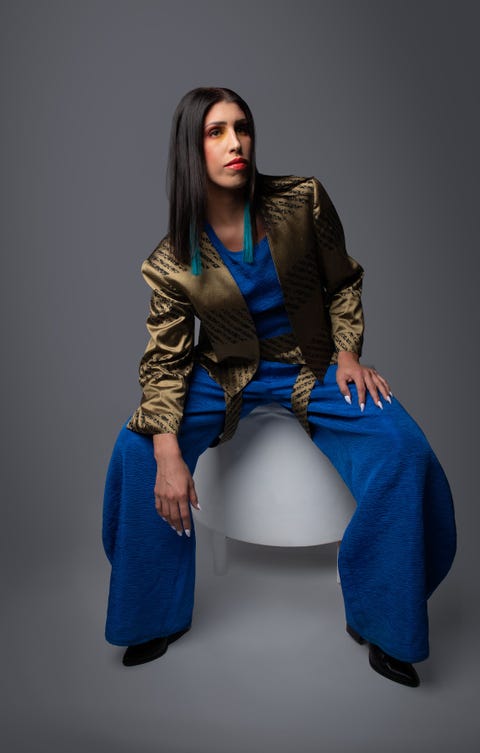Jewelry designer and metalsmith Margaret Jacobs has a hard time finding the perfect venue for her work. “When I’m presenting at markets or craft shows, I find it challenging to find the right space for my jewelry,” explains the New Hampshire-based Akwesasne Mohawk artist. “A lot of people and institutions have very specific and stereotypical ideas of what they consider to be Indigenous design, which is mainly beadwork and silversmithing.”
Jacobs’ jewelry, on the other hand, centers on powder-coating brass—an industrial finish more commonly associated with bicycle frames and automobile parts. “My work is also nuanced and interconnected in a way that cannot necessarily be interpreted through a Western lens,” she says. “So I feel that it isn’t understood and appreciated the way that it could be.”
Indigenous Fashion Week Toronto (IFWTO), which kicks off on Thursday, is tailored to designers like Jacobs. The four-day virtual event showcases Indigenous-made designs from emerging, established, and under-represented artists, giving audiences a wide and authentic view of First Nations fashion and design. It was created by Founder and Artistic Director Sage Paul to challenge outdated perceptions, explore innovative ways to present and consume fashion, and amplify the visibility of Indigenous designers.
Paul founded the biennial event with a team of collaborators in 2018 after years of feeling like she didn’t fit in. “When I finished fashion school in 2006, I found it extremely difficult to break into the industry,” relates the Toronto-based designer, who is a member of the Denesuliné English River First Nation. “I found the mainstream fashion system to be elitist and misunderstanding of fashion outside of the Euro-Western construct. I didn’t understand at the time that the structure was built to maintain a class system that didn’t include me.”
Paul’s inspiration for the event came in 2011 when she released her first collection, a line that was publicized only among the local Indigenous community at a small gallery in Toronto. “I don’t know if I would call that breaking into fashion,” she laughs, “but it wasn’t until I worked professionally with other Indigenous artists that I began to see an ability to create a space for myself and others.” Since its launch IFWTO has quickly become an important forum for Indigenous designers, connecting them to Canadian, U.S., and global consumers, buyers, retailers, curators, and institutes.
When Paul put out the call for designers for this year’s show in April 2019, Jacobs says she felt a little nervous about applying. “I had been creating sculpture for some time but the jewelry process was still fairly new to me,” she says. “Creating a body of work in order to be selected was a big goal. I thought that even if I wasn’t chosen, it still gave me something attainable to work toward.”
Jacobs’ Blood, Bone, Beast brass jewelry collection for IFWTO explores the fragility of growth and decay in nature with natural materials frequently associated with Indigenous work such as antler, shell, and horn. “It’s sculptural but wearable,” she says. “As someone who has a modern aesthetic and uses an unconventional and industrial process, it makes it difficult to communicate the cultural context of my brand. There tends to be this expectation of pan-Indianism and for things to look homogenized even though there are nearly 600 different and federally recognized tribes in the U.S. alone.”
The expectation comes from being tokenized for so long, says Toronto jewelry designer Louise Solomon, who has also felt boxed in. “I have been overlooked in the past by people in positions of power because when they learn that I’m an Indigenous jewelry maker, they assume I must only make beaded earrings and the like,” says Solomon, who is of Ojibwe Tribe heritage. “I do bead, but it’s a small part of what I do, and like many beaders, I have my own style and my own look.” But the brush-off is often quick and resolute. “The mindset is that if they’ve seen one Indigenous piece of jewelry, they’ve seen them all,” Solomon adds. “They don’t understand my work as a trained goldsmith and artist.”
This “one-size-fits-all” outlook ends up having a mirror-effect because trivialization can turn inward. “Indigenous artists have a tendency to undervalue their own work,” Solomon explains. “It pains me to see my people selling beadwork, moccasins, or art at such a low monetary value when so much hard work and cultural expertise goes into the creations. The amount most people expect to usually pay just about covers the cost of materials.” She adds that the mainstream perspective that Indigenous art is “trinkety” or that it can be haggled and undermined needs to change. “Counterfeiting our culture by selling artificial items at dollar stores and gift shops should be unlawful,” Solomon says. “We have to stop the cheapening of our authentic and quality arts.”
No wonder then that, for her brand, Hand of Solomon, which focuses on high-end, avant-garde and statement pieces, Solomon says she “likes to push the boundaries of what is traditionally Indigenous in both fashion and ceremonial wear.” Her latest collection of “wearable art for the modern spiritual warrior,” tells the story of seven fictional, futuristic Ojibwe clan Mothers who represent the seven clans of the Ojibwe Tribe. “Each Mother draws on her ancestors for guidance and contemplates her own advice for the next seven generations to follow,” Solomon says.
Toronto fashion designer Jason Baerg, who is showing at IFWTO for the first time, believes in the power of fashion to change the narrative. His Ayimach collection, which in the Algonquian language of Cree means, “a fortunate change of events leading toward success,” is inspired by the energy of his Northern Saskatchewan Cree land and the resilience of his heritage. His bold separates feature “vibrant hues of red, yellow, blue, and green to remind us that all of the elements are interconnected,” Baerg says.
For Métis fashion designer Andréanne Dandeneau, IFWTO is a first, vital step toward inclusivity in the industry, but there’s much more work ahead. “Canada, for one, must train more Indigenous designers,” says the Winnipeg artist who will be showing “bits and pieces” of her clothing at IFWTO from her Heritage, Professional Comfort and Zero-Waste collections under her brand Anne Mulaire. “Design schools should be challenged to recruit more Indigenous youth. Indigenous students need more opportunities so that they can learn how to nurture their innate creativity, cultural histories, and stories of significance.”
It is only through such work that mass audiences will come to understand “Indigenous people aren’t just a part of history, they are a part of our present day culture,” says jewelry designer Margaret Jacobs. “We are very much alive, well, and creating innovative work.” For proof, look no further than the IFWTO runway.
This content is created and maintained by a third party, and imported onto this page to help users provide their email addresses. You may be able to find more information about this and similar content at piano.io








